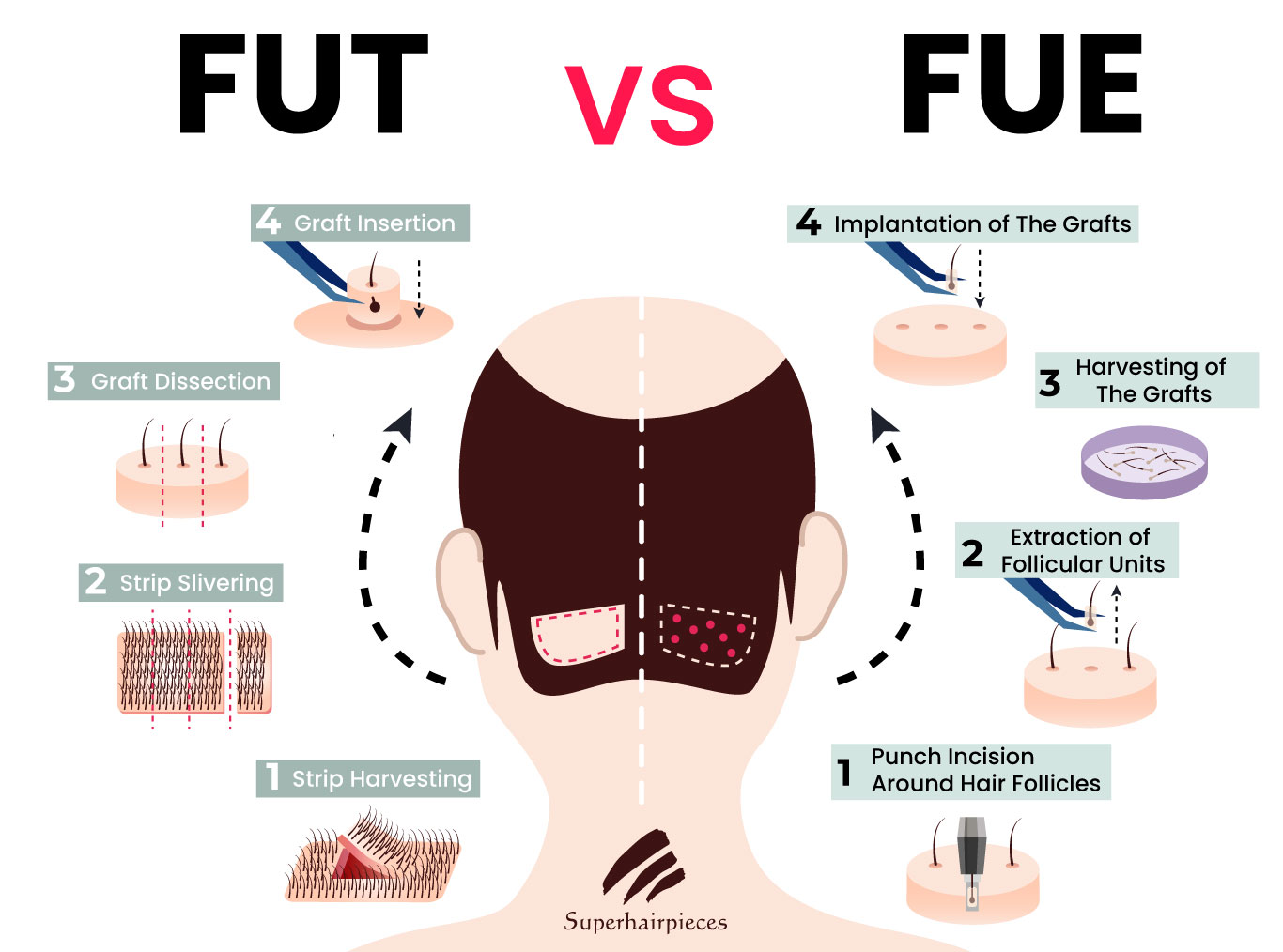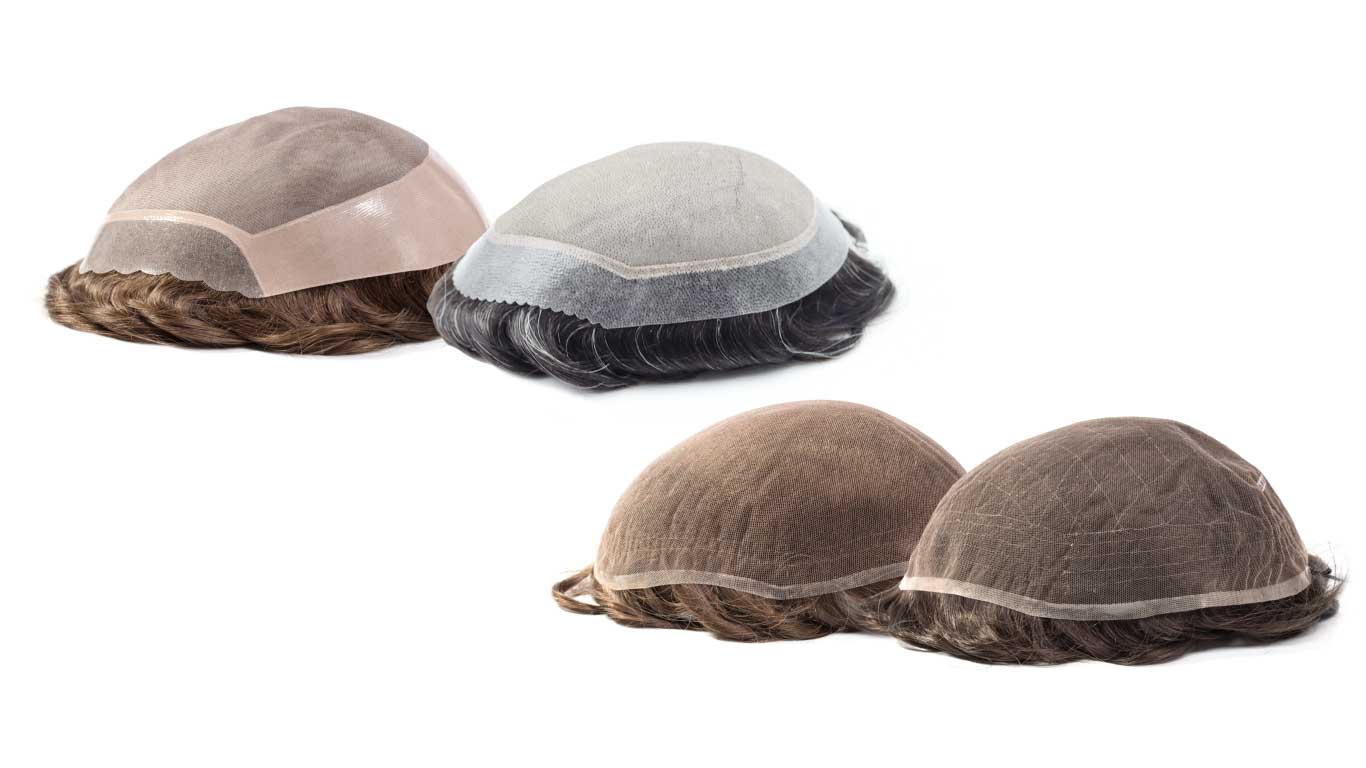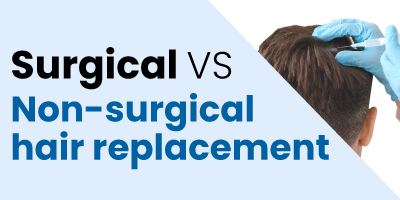Surgical versus non-surgical hair replacement: All you need to know
Posted by Hadi Azad Superhairpieces on Jul 05, 2022
Hair loss is a global issue faced by both men and women. It’s normal and can happen due to various reasons such as genetics, mental health, diet, and even medical conditions. You might feel overwhelmed with the number of solutions out there. This article will provide hair loss solutions and an in-depth explainer identifying the pros and cons of each hair loss solution.
Whether you’re experiencing small portions of bald patches or significant amounts of hair loss throughout the scalp, the hair loss solution that you’ll opt for will either be surgical or non-surgical. As you can imagine, there are pros and cons to each hair loss solution – at the end of the day, it’s your choice. Opt for a hair loss solution suitable for your lifestyle in which you feel good.
Surgical hair loss solutions
Hair transplant
A hair transplant is a surgical procedure in which hair is removed from the back occipital area of the head before being transplanted to the balding or hair loss area. There are two different hair transplant procedures – FUE and FUT.
FUE (Follicular Unit Extraction) is a procedure where individual hair follicles are removed from the donor area, situated at the back of the head where there is a plethora of hair, and planted on the balding or thinning area. On the other hand, FUT (Follicular Unit Transplantation) is when a strip of tissue is extracted from the back of the scalp, going from behind one ear to the other. The follicles are then individualized by a technician and placed on the desired balding or thinning area.

Pros
Eliminates baldness
Sometime after your hair transplant procedure, you will no longer have to worry about the bald spot or receding hairline anymore – hair transplants do work. You’re unlikely (in most cases) to see balding again, at least in the areas where you’ve transplanted your new hair. A hair transplant will add considerable thickness and volume to thinning or balding sections of the scalp.
Improves self-confidence & appearance
Hair loss is difficult to cope with – people tend to feel self-conscious about the way they appear after hair loss. Losing a part of your identity can harm your confidence and self-esteem. Hair loss can affect other aspects of your life as well like interacting with others, job performance, and your personal life. Hair transplants help solve this problem as it covers up unwanted hair loss.
Low-maintenance
After a successful hair transplant surgery, you will find that the new grafts are easy to maintain. The doctor will usually prescribe medication or hair cream used for a period of time after the hair transplant. There isn’t a need to purchase any special shampoos specifically for the newly placed grafts – however, ensure that after washing your hair with a gentle shampoo, you pat your scalp dry with a soft towel.
Cons
Not suitable for everyone
Hair transplants are limited to certain individuals as the procedure can further harm the hair loss situation of people with specific conditions. For one, hair transplants aren't suitable for people who don’t have enough hair on the back and sides of their heads for grafts. This can be because they are already dealing with extreme hair loss or if they’re undergoing chemotherapy. It’s also not suitable for individuals who have formed scars after an injury or those who have undergone head surgery.
Permanent scarring & takes time to see results
In most cases, the FUT transplant will notably leave permanent scarring on the extracted donor area. This also means that it’s unlikely to see hair growth on the back of the head. Let’s say hypothetically, your hair transplant procedure fails; there are only a number of grafts that are left on the side and back of your head that can be extracted. If you have a lack of hair to begin with, it will be an issue you won’t be able to overcome. It’s important to also note that the results from hair transplants aren’t instant. It can take from six to 12 months for noticeable growth and development.
Complications
Side effects from a hair transplant procedure usually clear up within a few weeks – however, listed below are symptoms an individual might face after a hair transplant:
- Swelling of the scalp, forehead, or face
- Bleeding
- Infection or inflammation of the scalp
- Unnatural-looking bits of hair
- Itchiness
The listed side effects last for a few weeks. To overcome these side effects, you will have to follow your doctor's orders and take pain medication, antibiotics to reduce the risk of infections, and anti-inflammatory medications to maintain low levels of swelling. Hair transplants are risky – if you end up not liking it for various reasons such as looks or maybe it turned out to be a botched transplant, you will have to live with it as hair transplants are irreversible. At the very least, you’ll have to shell out more money to fix it.
Superhairpieces floor manager Tara Gehart, an expert in the hair replacement industry, had this to say. “If you don’t like the result [of the hair transplant], you could try to add more hair, but different kinds of issues can arise like scarring alopecia.”
Additionally, while transplants do result in hair growth, you are unlikely to get the hair density you’re expecting. “You’re never going to get the [hair] density [from hair transplants] that you’re going to get from a hair system,” said Tara. “People are usually thinking back to when they were 20 with this great head of hair – it’s not a realistic expectation when it comes to transplants.”
Expensive
Hair transplants are expensive and are usually based on the number of follicles transplanted. The hair replacement surgery costs an average of $4 to $8 per hair follicle based in Canada and could cost upwards of $20,000. With the procedure usually being paid upfront, that’s a lot of money to spend.
It’s known that people travel to Turkey for a more affordable hair transplant, however, a cheaper alternative always carries the potential risk of a botched transplant. But don’t worry – there are other cost-effective solutions to hair loss!
PRP therapy

PRP – known as platelet-rich plasma therapy for hair loss – is a surgical procedure in which blood is taken and spun in a centrifuge. The separated PRP is then injected into the patient’s scalp where the hair is thinning. It’s believed that PRP injections act as a catalyst for natural hair growth increasing the density of miniaturized hair follicles. PRP is used as it is a growth factor currently used in sports medicine to heal injuries – PRP therapy supplies additional processed blood to the hair follicles which thickens the hair and provides a fuller look to the scalp.
Listed below are the advantages and disadvantages of PRP therapy:
Pros
Natural-looking
Your friends and family won’t be able to tell that you went to therapy to resolve an issue related to hair loss – that’s because undergoing PRP treatment for hair loss is undetectable. When the needle injects into the scalp, it uses your blood. As a result, this will generate hair restoration so the color, texture, and thickness of the hair will be similar to the natural hair.
Convenient
PRP treatment therapy is non-invasive – you can get the treatment done without substantial procedures and a short recovery process. PRP therapy treatment consists of three treatments that can take up to six weeks in total.
Cons
Potential side effects
The good news is that PRP treatment involves drawing your own blood which is processed, then injected back into your scalp – getting a contracted disease is unlikely. However, any treatment that involves needles and injections carries potential risks and side effects like injury to nerves or blood vessels, scars, and infection.
Not suitable for everyone
PRP therapy is harmful to individuals who face other medical conditions as it could further harm their situation. Moreover, stay away from PRP treatment for hair loss if you are a heavy smoker, have a history of drug or alcohol misuse, or are on blood thinners. If you are worried about side effects or are a part of these restrictions, you can always opt for non-surgical hair loss solutions like hair systems which we’ll discuss next.
Non-surgical hair loss solutions

Hair replacement systems
Hair systems (toupees and wigs for men) are progressively becoming more popular and accepted in today’s world. The beauty of owning a hair system is that it provides plenty of versatility. You won’t have to worry about being in pain or having to take medications. Owning hairpieces is a quick solution to hair loss. Depending on the hair system you opt for, hairpieces can also be extremely natural-looking and undetectable. Listed below are the pros and cons of hair replacement systems:
Pros
Reversible
Unlike hair transplants, if something goes wrong with a hair replacement system installation, or if you don’t like how the wig or toupee looks, it can always be reversed. Hair transplants are permanent. If you’re unhappy with the outcome of the hair transplant, changing or fixing the issue will not be feasible. On the other hand, hair systems offer versatility. If you dislike a hair system, switch to a more desired hairpiece. If you’re not a fan of hair systems in general, you have the freedom to simply take them off in a matter of minutes and stop wearing them. It’s that easy!
No side effects
The only side effect of wearing a hairpiece is a positive one since it provides full coverage of the head if desired! On its own, a hair system should never affect you or your hair if it is properly installed, removed, and maintained. However, ensure you undergo a skin patch test before using any glue or hairpiece tape to prevent the potential risk of irritation or itchiness.
Convenient and instant
The beauty of going through with a hair system is the convenience. It doesn’t take long to install as hairpieces are easy to attach and remove. Moreover, you don’t have to wait several months to see a result – as soon as you complete attaching the hairpiece to your scalp, you’re good to go. Whereas with surgical procedures such as hair transplants, it could take up to a year to see proper hair growth.
Hair loss is a harsh reality. Being stripped away from a characteristic that showcases your identity fades away. There is no longer a reason to worry – hair systems boost confidence and bring back the identity that you were seeking. In the process, you get your hair, self-esteem, and life back!
Cons
Too many options
If you’re in the market for a hair replacement system, you might feel overwhelmed with the number of options available for purchase. However, many elements in a hairpiece require consideration before purchasing. You will need to research the different types of hair system base materials, the hair density, the color of the wig or toupee, and much more. While you can do your own research, another alternative is simply having an online consultation where you can explain your needs and lifestyle to find the perfect fit for yourself.
Regular maintenance
Like most things in the world, extending a product's lifespan requires consistent care. The same ideology applies to owning a hair system where maintenance is recommended at least once a week. Treat it as if it’s your natural hair and wash your hair consistently.
Hair systems are an integral part of developing confidence and self-esteem. All in all, hairpieces are one of the best, if not the best, solutions for hair loss. They carry many advantages compared to disadvantages. Moreover, they boast features and benefits surgical procedures are yet to offer – reversibility and instant results.
Hair loss medications

Hair loss medications are available to treat balding hair or to minimize hair loss. There are two notable medications for hair loss – finasteride and minoxidil. Finasteride is a prescription medication for men which is taken daily in a pill form and tends to take at least six to 12 months before seeing noticeable results. On the contrary, minoxidil is an over-the-counter non-prescription medicine – it comes in shampoo, foam, or liquid solutions. Minoxidil is applied twice daily for men and once daily for women. Similarly to finasteride, minoxidil takes several months before noticing hair restoration. Notably, finasteride acts as a catalyst for stopping hair loss and in some cases, can result in hair regrowth, whereas minoxidil doesn’t stop hair loss but can grow thicker new hair.
Pros
Treats hair loss
Whether the medicines prescribed or over-the-counter, hair loss medications do treat hair loss one way or another, provided there is a good amount of hair remaining. Specific instructions need to be followed daily and consistently. It might take up to six months to notice a difference in growth or hair thickness.
Easy to get your hands on
Finasteride and minoxidil are relatively easy to get your hands on. Finasteride is a prescribed medication and is a longer process to obtain compared to minoxidil. Your doctor will most likely give you a physical exam and/or ask additional questions to come up with a diagnosis – this is to ensure finasteride isn’t harmful to your system. However, if you are displaying signs of hair loss, it should be relatively straightforward to receive a prescription. As for minoxidil, you can simply buy it at a drugstore with no prescription.
Cons
Not a cure for baldness
Although hair loss medication can either stop hair loss or grow new thicker hair – hair loss medication is unable to cure baldness. More specifically, if you’ve already lost a good chunk of your hair, these medications will not likely help as it’s best to start them when initially dealing with hair loss. Moreover, using hair loss medication can take several months, sometimes over a year, to see any improvement.
Potential side effects
If you plan on taking hair loss medication you need to be aware of the potential side effects that you may experience.
Common
- Feeling dizzy or lightheaded when getting up from a lying position
- Cold sweats and chills
- Lowered sex drive
Less common
- Unusual weight gain or loss
- Breast cancer
- Redness of the skin and itchiness
Finasteride can’t even be touched by women because it passes through the skin and can harm an unborn baby. If a woman comes in contact with finasteride, the affected area should be washed immediately with soap and water. On the other hand, minoxidil can be used but it’s not an optimal choice for women. Spironolactone is a medication specifically for female pattern loss. Many studies have shown that a 200 mg daily dosage of spironolactone reduced hair loss by up to 62.9%.
Have to take it for life
Once you start taking prescription medicine for hair loss, you can’t stop. If you decide to stop, you can expect the hair you managed to grow to fall out. You’ll go back to your previous rate of hair loss once you stop because hair loss medication only works while the medicine is active in your system/hair. In short, you will have to take finasteride and/or minoxidil for life, or else any progress you make will be lost.
So, which hair loss solution should you choose?
There’s quite a lot to unravel here. Starting with surgical hair loss solutions, you can opt for the typical and popular hair transplant surgery or PRP therapy. Both surgical procedures are popular hair loss procedures and extremely common with most men dealing with balding, especially transplants.
With that said, lay out all your options before heading straight to surgical treatments. It's important to evaluate other potential options because if something goes wrong with any surgical hair procedures, there’s no going back most of the time.
“Though you could do a couple of different [hair] surgeries, you can only actually implant so many hairs into the head,” said Tara. “After that point, you’re not going to actually necessarily have that density that you’re looking for – so that’s the main reason why I would definitely pick a hair system over surgery.”
Hairpieces, meanwhile, are safer and more convenient to wear. Hair loss medication has potential side effects that can affect the body long-term. Hair transplants might need various surgeries to get the desired results, and it can end up being a very long recovery process. “The downside of surgery is it’s painful!” added Tara.
You will also most likely prefer a solution to cover baldness or patches on the scalp where if a mistake occurs, it’s not the end of the world. Hairpieces are this solution and they are generally affordable, with plenty of options that can suit your lifestyle and budget. Best of all, you can achieve a natural look instantly with wigs or toupees in a matter of minutes!
-------------------------------
Interested in learning more about hair replacement solutions such as hairpieces? Browse through our website at www.superhairpieces.com (US & International) or superhairpieces.ca (CAN)
Don’t forget to tag us at @Superhairpieces and #Superhairpieces on your social media channels to get a shoutout! And make sure to like us on Facebook, follow on Instagram, and subscribe to our YouTube channel!
 Likes
Likes



 USD
USD







